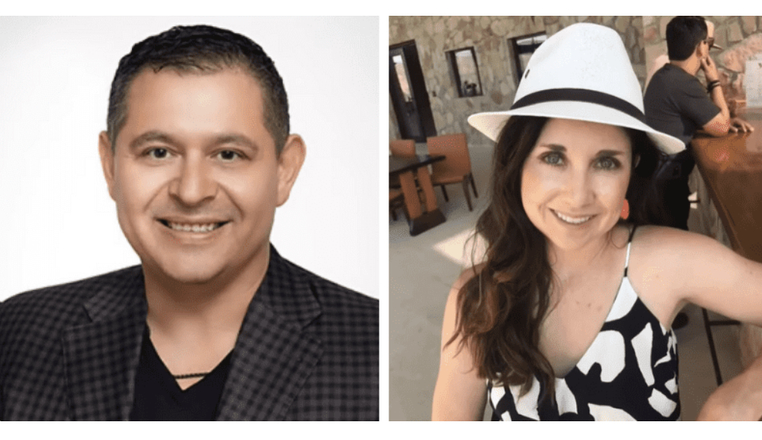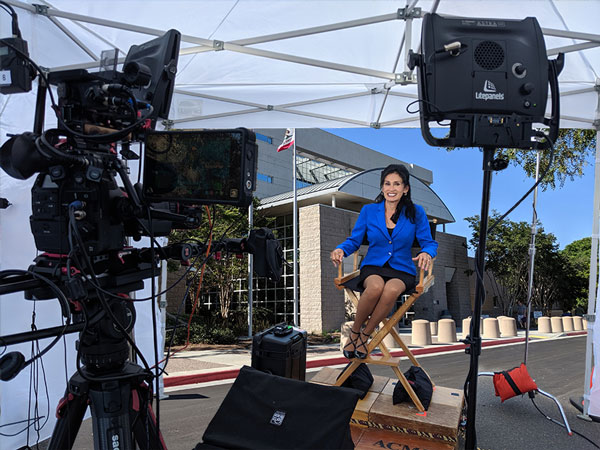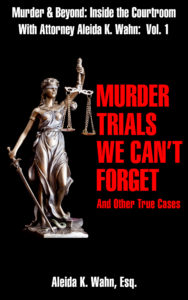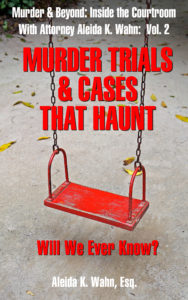
When thirty-six-year-old Megan Espinoza went in for breast augmentation surgery, could anyone have guessed that the loving mother of two young boys would never return home again? In the early afternoon of December 19, 2018, Megan Espinoza’s surgery began with plastic surgeon Dr. Carlos Chacon, at his private surgery center, Divino Plastic Surgery, in Bonita, California. It was supposed to be a routine surgery, but 85 minutes into the procedure, Megan Espinoza went into cardiac arrest, or as the defense maintains respiratory arrest, and by days end was transported to the hospital in critical condition. Never regaining consciousness, and left in a persistent vegetative state, six weeks later her family made the heartbreaking decision to let her pass, and she died on January 28, 2019. What exactly happened during that fateful surgery and the hours and days that followed?
That is a question which is currently being examined in a San Diego courtroom. Although Megan Espinoza’s family filed a wrongful death and malpractice action against Dr. Chacon, and his nurse, Heather Lange Vass, the San Diego District Attorney’s Office filed manslaughter charges against both on December 16, 2021. Then in a move which shocked many, on April 6, 2023, the charges for Dr. Chacon were elevated to second-degree murder, for which a conviction carries a sentence of 15-years-to-life. Dr. Chacon is now 48 years old. Nurse Vass pled guilty to involuntary manslaughter on May 16, 2023, and will be sentenced at a later date.
On September 21, 2023, Dr. Chacon’s preliminary hearing began in the courtroom of San Diego Superior Court Judge Maryann D’Addezio. Representing Dr. Chacon was attorney Marc Carlos, a veteran of high-profile criminal trials. At his side was attorney David Rosenberg, a specialist in representation of health care professionals. The prosecution was led by Deputy District Attorneys Gina Darvis and Hector Jimenez.
Although a preliminary hearing is not a full trial, but merely meant to determine whether probable cause exists to order the accused to stand trial, it appears the hearing will take on trial like proportions, estimated to last two weeks with the calling of extensive witnesses. Will answers finally be revealed as to what really happened on that terrible day?
Medical Expert, Surgeon John Shamoun, Takes the Witness Stand
The prosecution called their first witness to the stand: Dr. John Shamoun. A handsome plastic reconstructive surgeon from Newport Beach, he stated he holds six board certifications and has performed 15,000 – 20,000 surgical procedures. He was on the witness stand all day and at times clashed with attorney Rosenberg, raising his voice in anger and passionate contention, but never deviating from the belief Megan Espinoza need not have died.
Dr. Shamoun was retained by the California Medical Board to review the case, and stated he reviewed evidence including charts, reports, medical records, depositions, and video of the surgery itself.
Dr. Chacon used conscious sedation with a nurse
Before getting into the specifics of the surgery, Dr. Shamoun began his testimony by stating Dr. Chacon failed to achieve board certification as he failed the examination. He then went on to say Dr. Chacon admitted to no formal education in conscious sedation, which is a drug-induced depression of consciousness which allows patients to still respond to commands and to breathe on their own. Megan Espinoza’s surgery was under conscious sedation administered by nurse Vass.
The surgery was performed by placing the prosthesis underneath the pectoral muscle, and although the surgery has risks as the surgeon is working over the heart and lungs, Dr. Shamoun stated the surgery is commonplace. He also said it is usually done with an anesthesiologist. A certified registered nurse anesthetist (CRNA) can administer the anesthesia but under the supervision of an anesthesiologist.
Explaining further, Dr. Shamoun said the majority of surgeons use general anesthesia as it is safer, and the muscles do not move. He himself has performed more than 5,000 breast augmentations, but never under conscious sedation and never with a registered nurse. He believes in this case the nurse was used to save the expense of hiring an anesthesiologist.
Dr. Shamoun found eight extreme departures from the standard of care
Megan Espinoza had exertional asthma, but otherwise was in good health. She should have survived, said Dr. Shamoun definitively. In his review for the California Medical Board, he found eight extreme departures from the standard of care.
During the surgery, Espinoza’s blood pressure dropped suddenly, and her oxygen levels became very low. When a pulse could no longer be detected, Dr. Chacon began CPR. Dr. Shamoun said irreversible damage is done after five minutes of oxygen loss. Intubation is the quickest way to get oxygen to the lungs, but neither Dr. Chacon nor nurse Vass intubated Espinoza, which could have saved her life. Dr. Chacon had not intubated since his residency and nurse Vass did not know how to intubate. Dr. Chacon’s inability to rescue in extremis was a substantial cause of death.
Dr. Shamoun said Dr. Chacon did not properly handle the life-threatening situation. Although he was right to perform CPR, once the vital signs were restored, there must be transfer to an urgent care center. You call 911. Dr. Chacon did not call 911 in a timely fashion. Although Espinoza was given nine doses of Narcan, she did not wake up. She needed to be in a hospital as you don’t know what was going on. “There’s no reason to wait,” said Dr. Shamoun emphatically.
Moving on, Dr. Shamoun said Dr. Chacon did not employ a competent registered nurse and the incompetence of nurse Vass was a substantial factor in Espinoza’s death. He stated a nurse is not licensed to inject narcotics in California, and Vass was not a certified registered nurse anesthetist (CRNA). Yet, she administered Fentanyl, Demerol, and Ketamine.
Dr. Shamoun next said Dr. Chacon did not employ a competent surgical team and the incompetent surgical team was a substantial factor in Espinoza’s death. It was “essentially a circus when this occurred,” he stated animatedly. “I just don’t think they knew what was going on and they weren’t competent to take care of anything that was going on at that time.” Dr. Shamoun went on, “Testimony by people that she was shocked. Others saying there was no shock. CPR for 10 seconds, no pulse for 10 seconds, the use of Epinephrine on multiple occasions when there was a pulse. I mean, this was a circus. None of this stuff makes any sense.”
Dr. Shamoun came back to the delay in calling 911 stating Dr. Chacon failed to timely implement an emergency response. There was a three-hour delay in calling 911. “There’s no excuse for that!” he declared. Dr. Chacon called other doctors but gave them partial information. At the time of the 911 call, Dr. Chacon did not tell them Espinoza was unconscious, which he should have disclosed. He also left the room at times, which was not appropriate.
When asked the cause of death, Dr. Shamoun said it was respiratory depression caused by oversedation and not oxygenating for over five minutes. “Should she have survived?” asked attorney Darvis. “Yes,” responded Dr. Shamoun.
Prosecutor Darvis lists failures by Dr. Chacon which were dangerous to human life
Closing the direct examination, prosecutor Darvis listed the failures found by Dr. Shamoun. As Darvis addressed each point, she asked Dr. Shamoun: Is it dangerous to human life? Should Dr. Chacon know it is dangerous to human life? Does it show disregard to human life? To every question, Dr. Shamoun gave a resounding, “Yes.” The failures included:
- Failed to provide a competent anesthetic provider.
- Failed to provide a competent surgical team.
- Failed to prepare for emergencies during surgery.
- Failed to have ability to rescue.
- Failed to employ proper monitoring and observation of the patient.
- Failed to stay in the surgical room while the patient was in extremis.
- Failed to employ Advanced Cardiac Life Support procedures.
- Failed to call 911 in a timely manner.
And with this list ringing in everyone’s ears, it was now time for the defense to ask their questions.
Cross-Examination by Defense Attorney David Rosenberg
In a cross-examination that was at times combative, attorney David Rosenberg was prepared to go the distance having 22 pages of questions. In short order, he asked if conscious sedation was legal. Dr. Shamoun answered, “Yes.” When Rosenberg stated, “Conscious sedation is not beneath the standard of care?” Dr. Shamoun agreed it was not. Rosenberg then got Dr. Shamoun to acknowledge he himself has used a nurse for conscious sedation, although never for breast augmentation surgery.
Rosenberg next questioned about the amount Dr. Shamoun received as an expert. Dr. Shamoun replied $600 – $800 an hour, but stated he was only paid $150 an hour by the California Medical Board to review the case. His work had been about 50 hours of review. He made sure to note that he was not receiving any payment for his courtroom testimony though.
Rosenberg then moved into other reasons why Megan Espinoza could have experienced breathing problems. He stated she was taking the sleep sedative Lunesta and the antidepressant Lexapro which can interfere with breathing and can compound the effects of anesthesia. Dr. Shamoun agreed they could. Rosenberg asked if the nurse failed to obtain this information or failed to give this information to Dr. Chacon, if that would be below the standard of care. Dr. Shamoun answered, “Yes,” but then added the doctor was the one in charge and should know.
Rosenberg then questioned about the consent documents Espinoza signed. A listed risk was death, another possible brain damage. Dr. Shamoun agreed, but stated this was “boiler plate” language. He then said, “This patient in my opinion had no idea how she was going to go to sleep.” Rosenberg countered she did know as nurse Vass told her she was going to administer the drugs and that nurse Vass said she had done hundreds of cases. Dr. Chacon had standing orders, which were instructions for all patients undergoing surgery.
Rosenberg moved on to Espinoza’s condition, discussing her being reactive, moving and groaning. At this point, Dr. Shamoun lost his patience, and practically shouted that when the paramedics picked her up, she had a Glasgow Coma scale of 3, which is the lowest possible score. “Dead,” he declared. Not to be deterred, Attorney Rosenberg said at the hospital her eyes were reactive and she was moving and groaning. Dr. Shamoun said it could be seizure activity.
Rosenberg next centered on the time Dr. Shamoun said there was a hypoxic brain injury. At 1425 (2:25 p.m.) Espinoza had 100% oxygen levels, but at 1428 (2:28 p.m.), it was 40%. Rosenberg said they lost a pulse and Dr. Chacon gave 10 compressions and her blood pressure returned. “Would that indicate to you, no cardiac arrest?” Dr. Shamoun grew impatient stating if there is no pulse, there is no heartbeat, and that’s cardiac arrest. Again Dr. Shamoun said it takes five minutes to cause irreversible brain damage, to which Rosenberg countered the neurologists said there was no brain damage, and the autopsy report listed the cause of death as “accidental.”
Rosenberg next showed the efforts Dr. Chacon made for Espinoza, including connecting an AED, giving her CPR, Norcan, Epinephrine, fluids, and using an Ambu bag. Would he have done these things if he had no concern for her life? Dr. Shamoun answered Dr, Chacon did some things appropriately but many things he did not and added Espinoza was subjected to an inordinate amount of risk for which she need not have been.
Explaining further, Dr. Chacon stated nurse Vass said she deviated from the standing orders, giving Ketamine and Zofran. Neither were listed on Dr. Chacon’s drug schedule. Holding the drug chart Dr. Chacon used as a standing order for all patients, but which was devoid of specific orders for each patient, Dr. Shamoun exclaimed, “This chart is dangerous, very dangerous!” Rosenberg then asked, “If Vass never told Dr. Chacon she was given more medication, would that affect your opinion?” Dr. Shamoun said he would still say Dr. Chacon acted inappropriately.
Next Rosenberg moved to Espinoza’s cause of death. When Espinoza arrived at the hospital, she was reactive to stimuli and there was no determination of brain damage, said Rosenberg. He emphasized her date of death was January 28, 2019, six weeks after she left Dr. Chacon’s center and her death was from capping of the tracheal tube, even though she had vital signs. Dr. Shamoun would have not of it and said there was irreversible brain injury, and then nearly shouting exclaimed, “Vital signs have nothing to do with brain death!” She died from a hypoxic event during surgery and by not transferring her, insisted Dr. Shamoun. He then said he had evidence from the video taken during the surgery, and stated there was “multiple incompetence,” so much “I don’t even know where to start,” he concluded.
Rosenberg addressed the calling of 911, emphasizing anyone could have made that call. Dr. Shamoun disagreed, stating the doctor is the captain of the ship and has to make that call.
As the day was winding down, Rosenberg returned to the time “the event happened.” At 1425 (2:25 p.m.) Megan Espinoza had 100% oxygen levels, but by 1428 (2:28 p.m.) it was 40%. Brain injury occurs within 5-10 minutes and Espinoza went 15 minutes. “Even if the ambulance got there within two minutes, the injury already occurred?” questioned Rosenberg. Dr. Shamoun responded it is on-going and that’s why there’s a protocol, to get them to the hospital. Delaying three hours gave no opportunity to improve, for any recovery, he stated. She needed to be intubated.
Rosenberg moved to the cause of death, focusing on Dr. Shamoun’s report, where he wrote it could have just been an adverse reaction, or Espinoza could have had a seizure or heart arrythmia from natural disease. Dr. Shamoun now testified the adverse reaction was a red herring, and the seizure and heart arrythmia were low possibilities. He finished by definitively stating it was a sustained prolonged hypoxic event from oversedation.
It was now near 4:30 in the afternoon and it was time for the court to conclude. Dr. Shamoun will resume his testimony on October 9, 2023.
About Aleida K. Wahn, Esq.


I am an attorney, award-winning true crime writer, and legal analyst of criminal cases. I cover criminal trials and write stories and books about compelling, gripping, and unforgettable cases that impact our world. I take you into the courtroom in high-profile murder trials, rape cases, crimes of passion, cases involving mental illness, deviant behavior, and more. I have a deep passion for true crime, criminal law, and all aspects of the criminal justice system. I have appeared as an expert on true crime shows, including “48 Hours,” “Snapped,” and “The Dead Files,” and provided legal analysis on high-profile criminal trials on Court TV, the Law & Crime Trial Network, Fox 5 News, ABC 10 News, and KUSI News. I also create and host shows with the Del Mar Television Producers Group, addressing criminal justice and social issues in recent criminal trials.
I provided my insight and legal analysis on Court TV and the Law & Crime Trial Network of the high-profile trial of former NFL star Kellen Winslow Jr. It was a trial that captured the nation as the heralded ex-football star with fame, fortune, and a famous name stood accused of multiple rapes and other sex crimes involving five women. As the trial delved into shocking facts, complicated legal issues, and unexpected twists and turns, I was there for every minute. After the trial, I wrote a book on the case, going behind the headlines to share the extraordinary details of what happened inside the courtroom. Judging Winslow Jr.: From NFL Star to Serial Rapist? Inside the Shocking Rape Trial of Kellen Boswell Winslow II is now available on Amazon.
I am passionate about telling true crime stories, as these penetrating stories have the power to move us all, while highlighting societal issues which need to be addressed. I have personally seen the human devastation which is present in each trial and believe there is a lesson to be learned in every single case. It is through awareness and examining critical issues society can effect change and even make new laws. To learn more, please visit: https://www.aleidalaw.com.
Read about the gripping and unforgettable trials that I have covered in my latest books:



